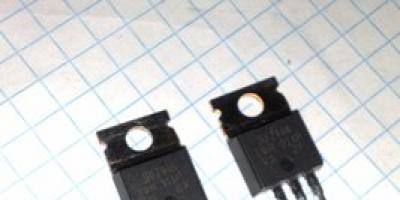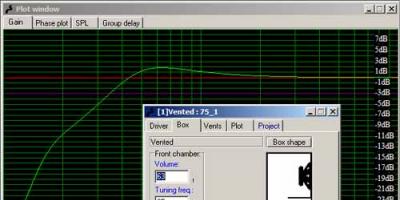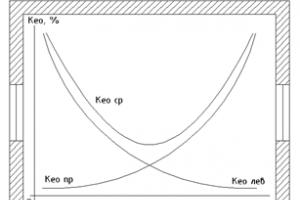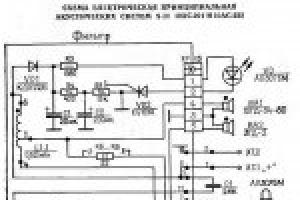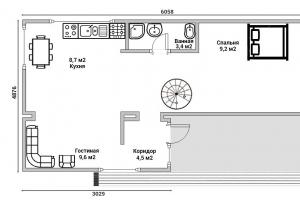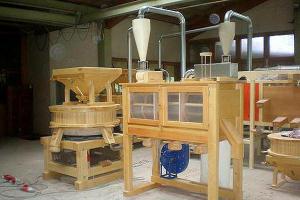Using the power of a vacuum pump.
The desktop itself milling machine- this is a horizontal surface that is designed to work with the part (it is fixed and securely based on it). This part of a milling machine is considered one of the most important - if the workpiece is not securely and evenly fixed relative to the movement of the cutter, then accurate and efficient processing will become unrealistic. Both the table and the cutting tool can move.
Milling machine work table with numerical control software It is equipped with longitudinal grooves where a number of clamps are placed to secure the part for processing or other necessary devices. But fastening with clamps has several disadvantages:
There must be mechanical clamping of the workpiece; the tightening force is set to the maximum.
Deformation and mechanical damage the front part of the manufactured part. Such consequences are absolutely undesirable for working with glass boxes equipped with backlighting - even the most minor scratches and cracks can completely ruin the appearance.
If the workpiece has some non-standard dimensions and shapes, then it is not always possible to select the required location due to the lack of symmetrical holes.
Difficulty with placement soft materials, which can bend when touched by a cutter (these are composite models with rather large dimensions). There is no way to install a large number of clamps on a table, so working with these types of workpieces is very difficult.
All of the above inconveniences can be solved quite simply - just install a vacuum table. It helps to securely fix the workpiece in the required place for precise machining with a milling cutter, without using mechanical clamps. The very essence of the work is that the air is pumped out, thereby reducing the pressure between the work table and the surface of the workpiece. This creates a kind of “suction cup” that firmly presses the part using atmospheric pressure. This helps to firmly and reliably fix the workpiece in the required position.
However, the vacuum table also has disadvantages:
– the impossibility of attaching very small parts or parts that are not sheet materials.
Usually, all manufacturers, when equipping a machine with a vacuum table, also leave the possibility of fastening with clamps, however, they are much smaller and they are no longer located as often as in a regular table.
– The compressor that maintains the vacuum requires a fairly powerful 5 kW, which usually leads to an almost doubling of energy consumption by the milling machine.
Therefore, every manufacturer must very carefully consider the pros and cons of vacuum fastening and make the choice himself.
Types of vacuum tables
Vacuum tables are divided into several types depending on the type of workpiece fastening:
Lattice. This type is most common, since it is easier to install and the cost is affordable. Thanks to its unique lattice design, it allows you to place required amount insulating material to enclose the workpiece around its perimeter. The pump pumps out air from the resulting circuit, thereby reliably pressing the part to the surface of the work table.
Vacuum tables VAC-MAT type. They are a rigid, durable frame made of polymer. It divides the space between the workpiece and the compactor into a number of sectors isolated from each other, from which air is then simultaneously pumped out. Thus, the vacuum is maintained even with the through type of milling; the compartments cannot be depressurized.
Slotted variety. They are indispensable when working with small workpieces, or with those parts on the surface of which there are many holes. Such a table is equipped with a number of grooves and compartments, some of which can be combined (if the holes match those on the workpiece).
Porous boards. They are recommended to be used for working with very thin material (like sheets of foil, for example). It can accurately reproduce the outline of the workpiece, the degree of impact depends on the area the “substrate” occupies. This vacuum material allows you to achieve high precision in processing and avoid errors. It is not permissible to work together with the coolant system.
Board type FLIP-POD. This a large number of separate suction cups-valves, which are designed for reliable fastening of even fairly massive workpieces. This system of vacuum tables does not involve covering the perimeter of the workpiece with a compactor, which makes it possible to process cutting tool edges of the part.
Almost all manufacturers of milling machines with numerical control offer the option of equipping their products with a special vacuum table. It is installed quite simply; there is no need to carry out any special operations or reconfigure the equipment - you just need to connect the compressor or vacuum pump.
Often CNC (Computer Numerical Control) machines are sold with a vacuum table. It is designed for fastening sheet parts with their subsequent processing. As a rule, processing of such workpieces is curvilinear in nature.
In this case, parts can be made from the most different materials– Chipboard, veneer, plywood. Most often, vacuum tables are used on milling machines that process solid sheets (for example, in the manufacture of furniture).
What does a vacuum table look like?
This device is a processing surface with a coating divided into sectors. Special suction cups and grooves are evenly distributed over the area of the device, which secure the workpiece in the required position. The larger the area of the vacuum table, the more functional and expensive it is.
The workpieces are fixed using a special vacuum pump. It is he who is responsible for reliable fastening of the workpiece to the table surface. Thanks to this invention, curved processing of sheet parts with large dimensions became possible.
It is noteworthy that vacuum vacuum cleaners are preferably used for processing wooden workpieces. If there is a need to perform similar work with metal, then magnetic tables are used for these purposes.
It is worth noting that depending on the size and functionality, the price of vacuum tables can vary significantly. At the same time, even the cheapest factory vacuum table will cost the buyer at least 150-170 dollars.
You can also purchase a used device, but the quality of such a table will always be in question. It is because of the factors listed above that many craftsmen create vacuum tables at home.
How to make it at home?
Vacuum clamp for plastic molding
It is possible to make such a device at home, but it is not an easy task. You need to understand the specifics of the device’s operation and the principles of its structure. Any stable sheet material, for example MDF, is suitable for forming a vacuum table. We create the contours of the table like a box and drill holes on the front side of the panel using an ordinary drill.
We attach special legs to the same box and install partitions with holes with a diameter of 7 to 8 centimeters. We do all this to add stability to our table and prevent it from deforming during use.
Energy source (for plastic molding)
Non-chrome wire is often used as a heater. This approach entails quite high costs, in addition suitable material quite difficult to find. As an alternative, you can use halogen lamps. It is better to sacrifice the heat level, but get affordable and effective heaters for your homemade vacuum table.
Halogen lamp sockets should be installed in pre-drilled slots in the metal sheet. We make tracks for conducting current from printed circuit boards, install them on the base and only then solder them. Otherwise, you will have to spend a lot of time soldering the tracks. The panel with light bulbs must be in a box with a lid that will allow servicing of the device.
This approach to creating a heat source allows you to heat the entire area, and, if necessary, only individual areas. But to make such a “smart” device, you need to pay more attention to connecting the lamps.
Control system
Key Vacuum Table Controls:
- Symmetrical thyristor with operating parameters from 20A and 240V. Its function is to regulate the heating process and coordinate the operation of the fan.
- Front panel with liquid crystal display. The table interface should display the status of each heating row. The panel also contains the device activation key and an emergency shutdown button.
- Board with electromechanical relays (6 pieces). 5 relays activate the heater lines, and the sixth one activates the fan.
- Table temperature indicator.
- Neutral relay board. It consists of electromechanical relays (7 pieces). Their function is to connect the heater lines to the neutral cable.
- Microcontroller with board (ATmega644). It is to this device that the temperature sensor, pressure indicator, display, mode switch, and relay board are connected.
- Control node alternating current. Its function is to compare the signal from the microcontroller, the symmetric thyristor and the AC lines.
Installation of supports for heaters is carried out on a box that has been prepared in advance. After this we install the heater panel. It is also necessary to install a special frame for plastic. We insert it into the supports on special bearings. To better secure the frame around the perimeter of the table, use insulating tape.
The key element of the vacuum table is the fan, which must be attached to the underside of the box. It is worth noting that the vacuum source can be mounted using an additional plate and neoprene gaskets.
After the final creation of all the key elements of the vacuum table, you can begin its installation. Before testing, you should check the quality of all connections, the uninterrupted and safe operation of the electrical equipment of the machine and table.
A similar type of table, only without heating lamps, is also suitable for a milling machine. Thus, we have described for you the independent development and installation of the most complex type of vacuum tables designed for plastic processing. To work with metal or wood, it is enough to correctly make only the lower part of this device.
Instead of a fan, you can use a vacuum source powerful pump. In the place where the heating elements are located at the plastic table, you should have a milling machine.
Video: vacuum table.
Important nuances
- A special vacuum generator can be used as a source of vacuum. It looks like a small box with a hole for air outlet and vacuum inlet. Also, for devices of this type, an indicator must be installed to measure vacuum indicators.
- The ejector and its level of performance depend on the speed and volumes of air that fly past it. That is why it has little to gain compared to a conventional vacuum pump. After all, to create a high-quality vacuum, you should also use a high-quality compressor. The fact is that to fasten a large part over the entire area of the table, a fairly weak compressor is enough, but to fix a small plate, you need to use a more powerful unit.
- An ordinary industrial vacuum cleaner is poorly suited for creating vacuum clamps, since it is not very suitable for working with a completely closed hose. That is why it is recommended to use a special vacuum pump.
With details large sizes a large vacuum table is required. Such equipment is very expensive due to the complexity of transportation and is not always suitable for certain tasks, but you can design the table yourself, under custom size and needs.
Vacuum tables for CNC are designed for milling machines that work with large sheets of wood or metal. Most CNC machines use curved machining. To work on milling machines, you need a surface that reliably holds the workpieces. Vacuum table presses products to the surface, preventing them from moving, making work on the milling machine more accurate and comfortable. In addition, complete equipment provides heating to the required temperature. It is more versatile than a magnetic table, which is only suitable for processing metal products.
Quite often, CNC milling machines come complete with a vacuum table, but if it is absent or is not large enough, another device is required. In this case, you can buy a used device of questionable quality or make it yourself.
Required materials and tools
To make a vacuum table for a milling machine, you need to find all the components. To create functional equipment you will need:
- wooden or a metal sheet appropriate size;
- metal profile;
- Vacuum pump;
- a heating element;
- Control block.
Tools you will need: drill, screwdriver, spanners, soldering iron. The remaining tools are used optionally, if available.
Manufacturing stages
After acquiring all the necessary materials and tools, you can proceed to self-assembly table.
Manufacturing of working surface and box
At the beginning of making a vacuum table for CNC, you need to create a working surface with your own hands. To do this, take a pre-prepared sheet of material. Holes are carefully drilled in it, in a checkerboard pattern, using a drill or screwdriver. Later, from the back, the surface will be adjacent to the vacuum pump, which serves to securely fasten the products. To increase the reliability of the structure, partitions are installed. They prevent the table from deforming during use.
Box
The most significant thing here is the height, since the table is designed for a numerically controlled machine. A stable structure for fastening is assembled from metal and wooden parts work surface. The surface above the working area will act as a holder for the heating element. It is desirable that the box be collapsible: this will facilitate further work, setting up equipment or transporting the table in the future.
The desktop should be as stable and reliable as possible. Therefore, it is advisable to avoid short-lived or moving connections in the design. To make it easier to move the tool, you can use adjustable height feet. This will allow you to work on uneven surface, providing stability.
A heating element
Vacuum forming of plastic also requires a special table. During operation, the product is exposed to a vacuum field and a heating element, which heats the plastic to the required temperature. To do this, a heating panel is installed above the table. Nichrome thread has proven itself best as a heating element. However, due to the high cost of the material, as well as the difficulty of finding it for free sale when self-production Usually halogen lamps are used.
Among the advantages of use should be noted uniform heating, as well as quality lighting work area.
A sheet of metal is taken as a workpiece. Holes for lamps are also drilled in it, after which the heating elements are secured and the electrical part is installed. All lamps must be connected in parallel. With more complex design the electrical part is output to the controller or separate switches to heat certain parts working area. The connection is made using soldering and copper wires. To reduce wiring, have a more pleasant appearance, ease of operation and greater reliability of wiring, it is recommended to use printed circuit board or several small boards. The design of the light panel should also be dismountable for maintenance.

Vacuum pump
The most important piece of equipment. Serves to create a vacuum and securely fix the part. It is best to use a specialized vacuum generator with a pressure gauge. If a dedicated vacuum pump is not available, several vacuum fans will do. It is possible to replace them with industrial vacuum cleaners, but in practice their efficiency is lower.
When connecting, it is important to reduce the air flow as much as possible, that is, insulate from the entrance to the working surface. A pressure gauge is needed to measure the results: too much vacuum can damage the part, work surface or equipment. With a more complex table design, the heating part regulators and pressure gauge are installed in the control unit.
Control block
The electronic part of the vacuum table is needed to effectively regulate the heating of the working area and create a more stable fixation of parts. There are many options for implementing a control unit; the biggest role here is played by a milling machine and numerical control installed in the working equipment. The most optimal one is selected based on the tasks, budget, and availability of specific elements. For optimal performance A microcontroller with a display and one relay for each control unit are required.
For comfortable work Temperature and pressure sensors are used. With the minimum configuration, one sensor and 2 relays are required: one for turning the pump on/off, the other for control heating panel. To delimit the work area, use the clamp and heat only for part of the table, it is necessary to use a larger number of relays and, accordingly, a more productive controller. Installing a reliable control unit will make work more comfortable and will allow you not to be distracted by pressure gauge readings.
Vacuum clamp for workpieces: pumps or blowers?
Currently, in various industries of processing metal, wood or plastic products, the so-called “vacuum clamp” is used to hold the workpiece on the work table instead of mechanical devices. With this holding method, a force is used that presses on the workpiece, pressing it against the table, from which air is pumped out and a vacuum is created. This force pressing the workpiece appears immediately after the air begins to be pumped out of the table and disappears when air enters there again.
The clamping force can be assessed in familiar quantities and calculated what it can be. Since it is a consequence of the vacuum created in the table on which the workpiece is located, or rather the difference in air pressure inside and outside the table, its maximum value is equal to the product of one atmosphere times the area of the workpiece being pressed. Since it is impossible to pump out air deeper than one atmosphere, then the “working pressure” to create this force cannot be more than 10 tons per 1 square meter.
What devices allow this method to be implemented?
The most correct, reliable and effective is to use vacuum dry rotary vane pumps. These pumps, although they do not create the theoretically possible maximum vacuum, guaranteeing the coveted 10 tons per square meter, are capable of pumping out 88% of the air and creating a pressure drop of up to 8.8 tons per square meter. At the same time, unlike, for example, oil ones, which have a better residual pressure indicator, they are more convenient to use and are better suited to work at intermediate pressure values (below atmospheric, but above the maximum residual pressure). In addition, like all vacuum pumps, they are not afraid of operation with completely blocked suction and discharge pipes.
The second most correct and popular applications (which, by the way, are constantly growing and are already comparable to the popularity of pumps) are Vortex blowers. If you connect a vortex blower with a suction pipe to a vacuum table, then it, working as a pump, is also capable of creating a vacuum, but the vacuum depth is 2-3 times worse than when pumping with a rotary vane vacuum pump. That is, a blower (with the exception of special high-pressure series) is, in principle, not capable of creating a vacuum deeper than 0.4-0.5 atmospheres. In addition, it cannot work for a long time with blocked pipes, as it will overheat and fail. This is where their weak points end and one can understand why in many cases they are preferred to rotary vane pumps.
There are many types of processing materials on vacuum tables, when, in principle, a large clamping force is not required or when, due to the large area of the workpiece, even a small pressure can create a force sufficient for clamping. This applies, first of all, to the processing of panels made of plastic and wood. The second important argument in favor of blowers is the size of the table and the impossibility of creating an absolutely sealed pumped volume - there is almost always a reverse movement of air into the system. Therefore, the pumping speed comes first - it is this that compensates for leakage. Pumps with a capacity of more than 150 cubic meters per hour is always more expensive than blowers with the same pumping speed and are heavier. And when customers see in the characteristics of a blower the maximum performance (one and a half to two times higher than the actual operating point), the blower, as an alternative to a vacuum pump, seems even more attractive.
Let's summarize. When should you choose a pump and when should you choose a blower?
If the dimensions of the table do not exceed 3-4 meters in length, the parts are small, of complex shape, the vacuum table is made with high quality (with a good fit of the parts and without possible leakage), it is required to obtain a pressure drop of at least 5 tons per square meter, then the best solution will oil-free rotary vane pump.
When the tables have linear dimensions of more than 5 meters, the workpieces being processed are also large and have small specific gravity, the tangential load (shearing the workpiece) is small and is compensated by a clamping force of about 10 tons for the entire part, which has an area of several square meters, the rigidity of the table does not guarantee the preservation of its shape during the vacuum process, the tightness of the system is low, and cost comes to the fore, then preference is given to blowers.
If you tell us the specific value of the clamping force, we can tell you and offer specific model pump or blower.
Machines and devices using vacuum clamping are used in almost all industries. We offer solutions for each of them: small-sized vortex blowers for holding sheets of paper or plastic in cutting plotters to specialized units capable of withstanding repeated ingress of cutting fluid into a vacuum system.
The performance of the vacuum pump used for vacuum clamping determines the speed of pumping out the system to the required pressure and, mainly, the ability to compensate for air leaks through leaks or cuts formed during material processing.
The pressure difference created by the vacuum pump determines the clamping force of the workpiece. Pumps with a large pressure drop are recommended for use in cases where it is necessary to achieve maximum clamping force at small area contact between the workpiece and the vacuum gripping device.

MSH blowers for vacuum tables of CNC machines 
This type of equipment makes it possible to provide high performance at a relatively small pressure drop. Devices of this type are used for pressing workpieces with a large contact area to the vacuum tables of CNC machines, for example, they can be used for pressing plastics, vinyl film, plywood, etc. sheet materials. An important advantage vortex blowers with high productivity is that when cutting through the material with a tool, as a rule, the possibility of continuing processing is preserved, because air leakage through the slot is compensated by increased productivity. Vortex blowers are extremely easy to use, have no wearing parts, and can be supplied with frequency converters, additional filters, mufflers and reversing automatic machines.
Elmo Rietschle oil-free rotary vane vacuum pumps for vacuum clamping systems
Machines of this type are most widely used in vacuum clamping systems. Not only do they create a pressure differential sufficient to clamp most types of workpieces and sheet materials, but they can also have quite greater productivity. Rotary vane oil-free vacuum pumps operate without the use of lubricants in the working chamber. These pumps are easy to operate and maintain. As standard, pumps in this series already have built-in air filters and mufflers.
Water-ring vacuum units ROBUSCHI (Italy) with closed water circulation for vacuum clamping 
Used as an alternative to dry rotary vane pumps. These installations can provide almost any performance required for vacuum clamping. They require virtually no Maintenance, resistant to dust, lubricating and cooling liquid, can operate for a long time with atmospheric suction pressure. While the cost for most standard sizes is lower than that of rotary vane vacuum pumps, they do not require the cost of consumable parts and pay for themselves very quickly.
Vacuum gauges and vacuum relays
In our company you will always find a wide range of vacuum gauges and vacuum relays necessary to monitor the operation and control of vacuum clamping systems. Our product range includes: mechanical and digital vacuum gauges, mechanical and electronic relays vacuum, as well as other accessories: filters for vacuum systems, inverse and shut-off valves, vacuum receivers, safety valves, fittings, vacuum hoses.
Working with MSH Techno Moscow (MSH Techno), you can be sure that the wide range of supplied equipment will allow you to choose exactly what is truly best suited for your tasks. If you have any questions about the equipment presented on our website, we will be happy to answer them!
Systematic Automation has been manufacturing vacuum tables for over 30 years.
Practically perfect surface(tolerance no worse than ± 25 microns / sq. ft.) - the result of a unique manufacturing technology and the use of high-quality equipment. Annually
Systematic Automation manufactures thousands of vacuum tables annually for a variety of unique applications: assembly manufacturing, CNC machining, forming, cutting, digital printers, photography, engraving, fabric processing, inkjet printers, research equipment, laboratory equipment, laminating, laser engraving and cutting, plotters, sail making, screen printing, ultrasonic cutting machines, presses, carpet cleaning.
Design of vacuum tables
The top of the table is made of durable aluminum alloy 3mm thick. Usage epoxy resin in design, provides good protection against dents and bends.
The base of the vacuum table has a “honeycomb” structure and is made of a material that reduces the effect of temperature differences on the unevenness of the table surface. The honeycomb design ensures uniform air flow across the entire surface of the table.
The “collector” measuring 25x25mm is located around the honeycomb base, due to which the best possible distribution of vacuum is achieved between all the holes in the table.
Hole size
In the standard version, the holes in the table have a diameter of 1.6mm, and are located in 12.5mm increments, which is optimal for most jobs.
Materials such as 127µm thick polycarbonate or vinyl will not deform against 1.58mm holes under the full force of a standard vacuum pump (see specifications).
Optionally, the holes can be custom-sized (minimum 0.79mm). The 0.79 mm holes are countersunk on the underside for minimal losses air flows.
Fastening
All tables have a 9.5mm flange around the perimeter for mounting. If the fitting for connecting the vacuum pump is located not at the bottom, but at the side, then there will be no flange on this side. If necessary, mounting holes will be drilled in the flange in accordance with the customer's drawing.
Standard parameters Options FAQ Video
External dimensions of standard vacuum tables. Vacuum holes are located 25mm from the edge.
- 127x152x30mm. (5″ x 6″ x 1 3/16″)
- 203x203x30mm. (8″ x 8″ x 1 3/16″)
- 304x203x30mm. (12″ x 8″ x 1 3/16″)
- 304x304x30mm. (12″ x 12″ x 1 3/16″)
- 304x406x30mm. (12″ x 16″ x 1 3/16″)
- 304x609x30mm. (12″ x 24″ x 1 3/16″)
- 304x762x30mm. (12″ x 30″ x 1 3/16″)
- 355x355x30mm. (14″ x 14″ x 1 3/16″)
- 406x279x30mm. (16″ x 11″ x 1 3/16″)
- 457x279x30mm. (18″ x 11″ x 1 3/16″)
- 508x406x30mm. (20″ x 16″ x 1 3/16″)
- 508x431x30mm. (20″ x 17″ x 1 3/16″)
- 508x457x30mm. (20″ x 18″ x 1 3/16″)
- 508x508x30mm. (20″ x 20″ x 1 3/16″)
- 558x558x30mm. (22″ x 22″ x 1 3/16″)
- 609x457x30mm. (24″ x 18″ x 1 3/16″)
- 609x558x30mm. (24″ x 22″ x 1 3/16″)
- 609x711x30mm. (24″ x 28″ x 1 3/16″)
- 660x355x30mm. (26″ x 14″ x 1 3/16″)
- 660x482x30mm. (26″ x 19″ x 1 3/16″)
- 660x508x30mm. (26″ x 20″ x 1 3/16″)
- 660x762x30mm. (26″ x 30″ x 1 3/16″)
- 660x863x30mm. (26″ x 34″ x 1 3/16″)
- 685x1016x30mm. (27″ x 40″ x 1 3/16″)
- 711x812x30mm. (28″ x 32″ x 1 3/16″)
- 762x508x30mm. (30″ x 20″ x 1 3/16″)
- 762x863x30mm. (30″ x 34″ x 1 3/16″)
- 762x1016x30mm. (30″ x 40″ x 1 3/16″)
- 914x914x30mm. (36″ x 36″ x 1 3/16″)
- 1219x1219x30mm. (48″ x 48″ x 1 3/16″)
- 1219x2438x38mm. (48″ x 96″ x 1.50″)
- 1828x3657x38mm. (72″ x 144″ x 1.50″)
- Tables available in custom sizes. Please check.
- Vacuum pump
- Vacuum valve
- Vacuum table air supply valve
- Pressure force regulator.
- Pedal
- Stops for positioning products on a vacuum table.
- Extendable vacuum tables
- Plastic (Formica) table top
- Independent vacuum zones controlled by valves.
- Anodized table surface
- The location of the vacuum holes according to the customer's drawing
- Table shape and size according to customer requirements
Q: How can I secure the vacuum table?
A: The table has a 9.5mm bottom and top flange around the perimeter. You can use them for clamps or drill holes for fastening.
Q: Is it possible to use threaded connection for vacuum liner?
Oh yeah. Please indicate the required size.
Q: I already have a vacuum pump. Will it work with your vacuum table?
A: Most likely it will work. In any case, you can order the pump later. If you decide to use your own pump, you can immediately order an adapter/adapter. When ordering, please indicate dimensions.
Q: I work with materials that can be scratched. Is it possible to avoid them when working on a vacuum table?
A: Yes, you can use the switch valve to blow air out of the table. This will have the effect air cushion. Optionally, you can adjust the amount of incoming air. To operate the valve, compressed air is required at a pressure of min. 4.2 bar.
Q: How much Smooth surface vacuum table?
A: Tolerance no worse than ± 25µm/sq.ft.
Q: How should I secure the table to prevent bending?
A: As a rule, the lower part (surface) of the table is flat and parallel to the upper part, therefore, the table can be mounted on the base of the machine.
When installing the table on a surface, pay attention to the absence of gaps that indicate unevenness of the surface. Use shims to eliminate table wobble due to gaps. Check parallelism. If necessary, use additional spacers to eliminate the possibility of table bending under pressure and disruption of the plane of the working surface of the vacuum table.
Q: Is there a way to place items on the table in exactly the same place?
A: Yes, it is possible. Optionally, you can order a stop system for positioning products. As a rule, these are three steel pins that are “pushed out” from the table while the product is being placed and “recessed” into the table as soon as the vacuum is turned on. It is possible to place more than three pins.
Find out the price!
The manufacturer reserves the right to make changes to the design and specification of screen printing equipment without notice.

